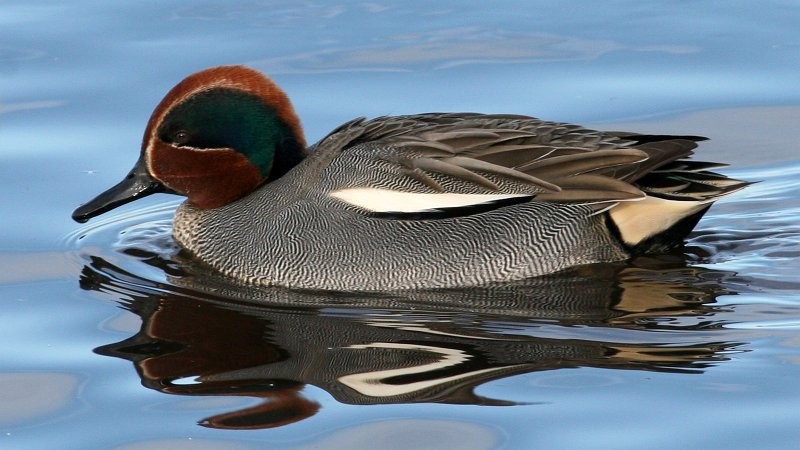Green-winged Teal
A species of Anas, Also known as Common Teal Scientific name : Anas crecca Genus : Anas
Green-winged Teal, A species of Anas
Also known as:
Common Teal
Botanical name: Anas crecca
Genus: Anas
Content
Description People often ask General Info
 Photo By Ken Billington , used under CC-BY-SA-3.0 /Cropped and compressed from original
Photo By Ken Billington , used under CC-BY-SA-3.0 /Cropped and compressed from original Description
The green-winged Teal is a small duck primarily found around aquatic areas. It can also occasionally be seen on mudflats searching for vegetation. The duck often forages for submerged vegetation by tipping its slender beak in the water. It has a wide range that includes most continents including Asia, North America, and Europe.
Size
30-41 cm (12-16 in)
Life Expectancy
16 years
Nest Placement
Ground
Clutch Size
6 - 9 eggs
Number of Broods
20 - 23 days
Feeding Habits
Green-winged Teal forages in shallow waters, mudflats, and fields, eating aquatic invertebrates and various seeds. Diet consists of sedge fruit, pondweed, grass, smartweed, sea purslane, bulrush, dwarf spikerush, swamp timothy, and crops like corn and rice. Also consumes midges, tadpoles, molluscs, crustaceans, and particularly insect larvae in chicks under two weeks old.
Habitat
Green-winged Teal thrives in wetlands, favoring environments from river deltas to prairie territories. These birds seek cover in marshes and ponds, with a preference for shallow, weedy waters and areas with abundant aquatic vegetation. During migration, green-winged Teal relies on coastal marshes and flooded fields as stopovers. Their winter habitats include estuaries and agricultural lands, extending from temperate lowlands to subalpine regions.
Nest Behavior
The female green-winged Teal scrapes a nest bowl, adding nearby vegetation and her down after laying the final egg. Incubation starts post the last egg is laid, performed solely by the female.
Nest Characteristics
Green-winged Teal's nests are often sited on the ground within 200 yards of water, shielded by dense vegetation like sedge meadows or woods. These nests are shallow bowls, about 6–7 inches wide and 2–6 inches deep, lined with plant material and down feathers.
Dite type
Granivorous
People often ask
General Info
Feeding Habits
Bird food type
Behavior
Green-winged Teal exhibit remarkable agility as fliers, capable of lifting off directly from water without the need for a running start. These dabbling ducks commonly feed by tipping forward into the water, but will also dive when necessary for sustenance or to evade predators. In the winter months, green-winged Teal congregate in massive roosting flocks, sometimes numbering in the tens of thousands. Their courtship rituals, which begin in autumn and peak in the early months of the year, are characterized by a complex display of movements and calls, with males vying for female attention in sizable gatherings. Mate selection happens annually, often on wintering grounds, but continues during migration and at breeding sites. The males guard their chosen partners from rival advances but leave once egg incubation starts. Newly hatched chicks display immediate independence by swimming, diving, walking, and feeding, though the female provides night-time warmth and protection in inclement weather.
Distribution Area
The Eurasian teal breeds across the Palearctic and mostly winters well south of its breeding range. However, in the milder climate of temperate Europe, the summer and winter ranges overlap. For example, in the United Kingdom and Ireland a small summer population breeds, but far greater numbers of Siberian birds arrive in winter. In the Caucasus region, western Asia Minor, along the northern shores of the Black Sea, and even on the south coast of Iceland and on the Vestmannaeyjar, the species can be encountered all year, too. In winter, there are high densities around the Mediterranean, including the entire Iberian Peninsula and extending west to Mauretania; on Japan and Taiwan; as well as in South Asia. Other important wintering locations include almost the entire length of the Nile Valley, the Near East and Persian Gulf region, the mountain ranges of northern Iran, and South Korea and continental East and Southeast Asia. More isolated wintering grounds are Lake Victoria, the Senegal River estuary, the swamps of the upper Congo River, the inland and sea deltas of the Niger River, and the central Indus River valley. Vagrants have been seen in inland Zaire, Malaysia, on Greenland, and on the Marianas, Palau and Yap in Micronesia; they are regularly recorded on the North American coasts south to California and South Carolina. From tracking wintering teal in Italy, most individuals departed the wintering grounds between mid-February and March, using the Black-Sea-Mediterranean flyway to reach their breeding grounds, from central Europe to eat of the Urals, by May. This slow migration is due to long stopovers near the start of migration, mainly in south-eastern Europe. Altogether, the Eurasian teal is much less common than its American counterpart, though still very plentiful. Its numbers are mainly assessed by counts of wintering birds; some 750,000 are recorded annually around the Mediterranean and Black Seas, 250,000 in temperate western Europe, and more than 110,000 in Japan. In 1990 and 1991, a more detailed census was undertaken, yielding over 210,000 birds wintering in Iran, some 109,000 in Pakistan, about 77,000 in Azerbaijan, some 37,000 in India, 28,000 in Israel, over 14,000 in Turkmenistan and almost 12,000 in Taiwan. It appears to be holding its own currently, with its slow decline of maybe 1–2% annually in the 1990s – presumably mainly due to drainage and pollution of wetlands – not warranting action other than continuing to monitor the population and possibly providing better protection for habitat on the wintering grounds. The IUCN and BirdLife International classify the Eurasian teal as a species of Least Concern, unchanged from their assessment before the split of the more numerous A. carolinensis. The Eurasian teal is one of the species to which the Agreement on the Conservation of African-Eurasian Migratory Waterbirds (AEWA) applies. 
Species Status
Not globally threatened.